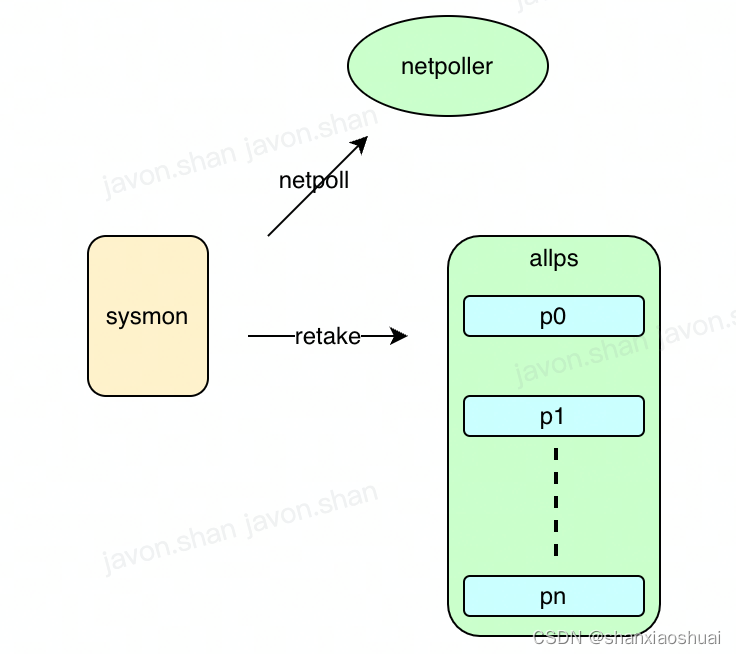调度系列
调度系列之goroutine
调度系列之m
调度系列之p
掉地系列之整体介绍
在golang的调度体系中,除了GMP本身,还有另外一个比较重要的角色sysmon。实际上,除了GMP和sysmon,runtime中还有一个全局的调度器对象。但该对象只是维护一些全局的数据,而不承担实际的调度职责,并不值得单独介绍,感兴趣的同学可以自己了解一下。
回到sysmon,sysmon是一个管理线程或者说守护线程,其是对GMP调度架构的补充和兜底。通过前面的几篇介绍,可以知道GMP的调度完全是主动协作式的调度。主动协作式的调度性能很高,但是在某些情况下会出现单个goroutine长期占据时间片甚至一直占据时间片的情况。
比如:
- 某个goroutine不执行主动调度、不调用系统调用、不做函数调用,就会一直运行直到goroutine退出;
- 某个goroutine处于syscall状态时也无法触发主动调度,可能会造成该goroutine长时间占据时间片;
sysmon的作用就是处理类似上面情况,其主要的工作内容有:
- 定期查看netpoll有无就绪的任务,防止netpoll阻塞队列中的goroutine饥饿;
- 定期查看是否有p长时间(10ms)处于syscall状态,如有则将p的持有权释放以执行其他g;
- 定期查看是否有p长时间(10ms)没有调度,如有则对当前m发送信号,触发基于信号的异步抢占调度;

在main函数启动时,会调用newm函数创建sysmon线程,sysmon作为mstartfn传入。
// src/runtime/proc.go 145
// The main goroutine.
func main() {...if GOARCH != "wasm" { // no threads on wasm yet, so no sysmonsystemstack(func() {newm(sysmon, nil, -1)})}...
}
在介绍m的时候,我们提到过,mstart中会先调用mstartfn,然后再获取p并调用schedule函数。由于sysmon函数是循环不返回的,所以对应的m(也就是线程)永远运行sysmon,并且不需要获取p。所以并不是所有的m都需要p才可以运行的。
接下来,我们看下sysmon的里面具体做了些什么。
- 进入sysmon可以看到里面是一个死循环,这和我们上面提到的一样。该循环并非一直忙等,而是会根据系统的情况进行延时睡眠,初始的interval是20us,最大的interval是10ms。
- 在某些特殊的情况,sysmon可以进入更长时间(超过10ms)的睡眠,条件包括:
- 系统不需要schedtrace。看起来是和调度相关观测的内容,如果需要schedtrace,则sysmon需要及时输出相关数据;
- 系统处于停滞状态。这个停滞是我自己描述的,不一定准确,包括两种情况:1. 所有的p都是空闲的,此时系统中没有任务执行;2. 系统在等待进入gc状态,马上要stop the world;
满足上面两个条件,则可最大进行1min的睡眠。1min是最大强制gc时间(2min)的一半。
- sysmon的活跃状态,首先会坚持netpoll是否超过10ms没有被检查过,这是为了防止netpoll挂载goroutine的饥饿;
- 然后会进行retake操作,retake的内容就是对所有p进行检查,查看p是否处于syscall或者被一个goroutine占据时间过长(超过10ms),如果有则进行相应的处理;
- 最后还会进行gc和schedtrace相关的操作;
// src/runtime.go 5134
func sysmon() {lock(&sched.lock)sched.nmsys++checkdead()unlock(&sched.lock)lasttrace := int64(0)idle := 0 // how many cycles in succession we had not wokeup somebodydelay := uint32(0)for {if idle == 0 { // start with 20us sleep...delay = 20} else if idle > 50 { // start doubling the sleep after 1ms...delay *= 2}if delay > 10*1000 { // up to 10msdelay = 10 * 1000}usleep(delay)now := nanotime()if debug.schedtrace <= 0 && (sched.gcwaiting != 0 || atomic.Load(&sched.npidle) == uint32(gomaxprocs)) {lock(&sched.lock)if atomic.Load(&sched.gcwaiting) != 0 || atomic.Load(&sched.npidle) == uint32(gomaxprocs) {syscallWake := falsenext := timeSleepUntil()if next > now {atomic.Store(&sched.sysmonwait, 1)unlock(&sched.lock)// Make wake-up period small enough// for the sampling to be correct.sleep := forcegcperiod / 2if next-now < sleep {sleep = next - now}shouldRelax := sleep >= osRelaxMinNSif shouldRelax {osRelax(true)}syscallWake = notetsleep(&sched.sysmonnote, sleep)if shouldRelax {osRelax(false)}lock(&sched.lock)atomic.Store(&sched.sysmonwait, 0)noteclear(&sched.sysmonnote)}if syscallWake {idle = 0delay = 20}}unlock(&sched.lock)}lock(&sched.sysmonlock)// Update now in case we blocked on sysmonnote or spent a long time// blocked on schedlock or sysmonlock above.now = nanotime()// trigger libc interceptors if neededif *cgo_yield != nil {...}// poll network if not polled for more than 10mslastpoll := int64(atomic.Load64(&sched.lastpoll))if netpollinited() && lastpoll != 0 && lastpoll+10*1000*1000 < now {atomic.Cas64(&sched.lastpoll, uint64(lastpoll), uint64(now))list := netpoll(0) // non-blocking - returns list of goroutinesif !list.empty() {incidlelocked(-1)injectglist(&list)incidlelocked(1)}}if GOOS == "netbsd" && needSysmonWorkaround {...}if scavenger.sysmonWake.Load() != 0 {// Kick the scavenger awake if someone requested it.scavenger.wake()}// retake P's blocked in syscalls// and preempt long running G'sif retake(now) != 0 {idle = 0} else {idle++}// check if we need to force a GCif t := (gcTrigger{kind: gcTriggerTime, now: now}); t.test() && atomic.Load(&forcegc.idle) != 0 {lock(&forcegc.lock)forcegc.idle = 0var list gListlist.push(forcegc.g)injectglist(&list)unlock(&forcegc.lock)}if debug.schedtrace > 0 && lasttrace+int64(debug.schedtrace)*1000000 <= now {lasttrace = nowschedtrace(debug.scheddetail > 0)}unlock(&sched.sysmonlock)}
}
retake的操作也相对比较好理解。在p的介绍中我们提到过schedtick、syscalltick、sysmontick三个字段,其作用正是为了sysmon的检查。

sysmontick表示sysmon观测到的调度和系统调用情况,schedtick、syscalltick为实际的调度和系统调用情况。因为sysmon会经常睡眠,所以两者之间会有差异。
- sysmon在检查所有p的过程中,如果发现sysmontick落后于实际情况,就会以实际情况为准更新sysmontick,同时也不会再做校验。因为sysmon睡眠最大时间为10ms,说明对应的p在10ms内做了调度。
- 如果sysmontick和实际情况一只,则要看p是否运行一个goroutine超过10ms,如果是,则对m发送信号,触发异步抢占调度;如果p处于syscall状态超过10ms,则将p的持有权释放执行其他g。
func retake(now int64) uint32 {n := 0// Prevent allp slice changes. This lock will be completely// uncontended unless we're already stopping the world.lock(&allpLock)// We can't use a range loop over allp because we may// temporarily drop the allpLock. Hence, we need to re-fetch// allp each time around the loop.for i := 0; i < len(allp); i++ {_p_ := allp[i]if _p_ == nil {// This can happen if procresize has grown// allp but not yet created new Ps.continue}pd := &_p_.sysmonticks := _p_.statussysretake := falseif s == _Prunning || s == _Psyscall {// Preempt G if it's running for too long.t := int64(_p_.schedtick)if int64(pd.schedtick) != t {pd.schedtick = uint32(t)pd.schedwhen = now} else if pd.schedwhen+forcePreemptNS <= now {preemptone(_p_)// In case of syscall, preemptone() doesn't// work, because there is no M wired to P.sysretake = true}}if s == _Psyscall {// Retake P from syscall if it's there for more than 1 sysmon tick (at least 20us).t := int64(_p_.syscalltick)if !sysretake && int64(pd.syscalltick) != t {pd.syscalltick = uint32(t)pd.syscallwhen = nowcontinue}// On the one hand we don't want to retake Ps if there is no other work to do,// but on the other hand we want to retake them eventually// because they can prevent the sysmon thread from deep sleep.if runqempty(_p_) && atomic.Load(&sched.nmspinning)+atomic.Load(&sched.npidle) > 0 && pd.syscallwhen+10*1000*1000 > now {continue}// Drop allpLock so we can take sched.lock.unlock(&allpLock)// Need to decrement number of idle locked M's// (pretending that one more is running) before the CAS.// Otherwise the M from which we retake can exit the syscall,// increment nmidle and report deadlock.incidlelocked(-1)if atomic.Cas(&_p_.status, s, _Pidle) {if trace.enabled {traceGoSysBlock(_p_)traceProcStop(_p_)}n++_p_.syscalltick++handoffp(_p_)}incidlelocked(1)lock(&allpLock)}}unlock(&allpLock)return uint32(n)
}

)

 消息中间件 NOTE)







)



)



